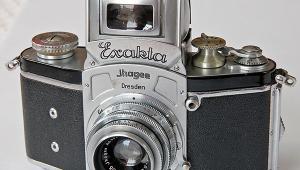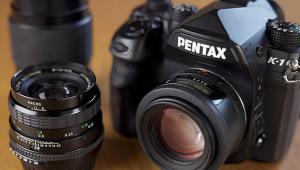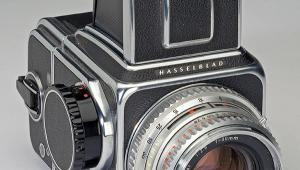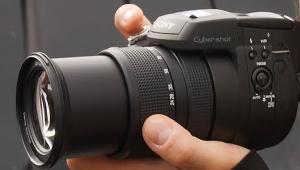Bilora Bella 44
Quite Simply, It's Cute
What determines whether a camera is collectible? Quality? Technical ingenuity? Commercial success (or failure)? All of these things--but some deserve to be saved from the scrap heap just because they are pretty. The Bilora Bella 44 has little else to commend it. The lens is indifferent; the shutter limited; the 127 film needed to feed it is hard to find; film counting is by red window; the 12-on-127 4x4cm format isn't too clever; focusing is by scale; and it's made largely of pot metal and plastic. But then you look at it...

I'm not even sure whether the silver finish is chrome plating or paint. From the places it's rubbed or chipped, I think it's lacquered chrome--a fairly horrible finish, but one that even Linhof used at times. It looks great for a few years, but sooner or later, it goes very nasty indeed.
But the combination of this soft, lustrous silver finish with gray, not black, leatherette on the front and back, and a gray ring around the "Synchro-Flash" shutter, is very attractive; and the little Bilora logo on a red background, above the viewfinder, sets it all off exquisitely.
There are several nods in the direction of versatility, too. The "Achromat f/8" lens--uncoated, two-glass unit--focuses from 1 meter to infinity. You can set two apertures, f/8 and f/11, and two shutter speeds, 1/50 (the sync speed) and 1/100, plus B. There's a tripod socket, and the shutter button is threaded for a standard tapered cable release. You have a choice of a standard PC nipple or a hot shoe (or had, in my case--the center contact is gone from the shoe).
On the other hand, there's no interlink between the shutter and the wind-on, so you can double-expose to your heart's content. One authority reckons there's double-exposure prevention built-in, but when I had mine apart (the shutter wasn't working at all when I got it) I saw nowhere that such a feature could have been installed.

The entire back comes off for loading. The plastic coaming over the middle of the back twists anticlockwise, and the back comes out parallel with the lens axis, straight backward, without sliding downward. Built into the coaming there's a spring-loaded metal cover for the red window counter, a tacit admission that by the late 1950s, this was a risky way to count exposures because of the risk of fogging through the backing paper.
Bilora is a long-established German concern, still seen at photokina today, but the only place where it says "Made in Germany" is on the plastic molding on the back. It's the usual 127 knob wind, though the knob is set in the top housing of the camera and is very easy to operate with the left thumb and forefinger.
Results? Quite honestly, I've never even tried it: I save my 127 film for cameras where I have a better chance of getting good pictures. I'd guess (from experience of similar cameras in the past) that you could get very good "en-prints" at 2x or even 3x; that's 8x8cm (just over 3" square) or 12x12cm (a bit under 5" square). By around 4x (16x16cm, 51/4" square) you'd start to get that "glassy" look that you get from over enlarging a too-small negative taken with an inferior lens. It's just a pity it's not a better camera.
It was introduced in about '58; I've also seen pictures of a later, more "modern" model, with satin chrome, but it doesn't look anything like as pretty. There was apparently an eight-on (645) model which would have given better results simply because a 3x enlargement would be 12x16cm, a respectable 5x7" or so.
But if there's one word to describe it, it's cute. All right, it's not in the same class as Kodak's immortal Bantam Special (for which film is even harder to find), but equally, it's a lot less expensive. I paid the equivalent of $6 for mine, and I think I'd have gone to $10; but if you go over about $20, or $30 if you're feeling flush, you've been had. Unless, of course, you find it so pretty you can't live without it.
- Log in or register to post comments

















































